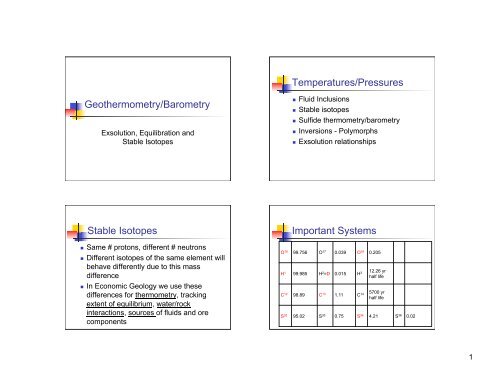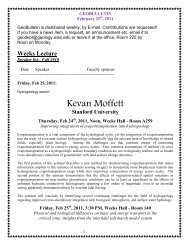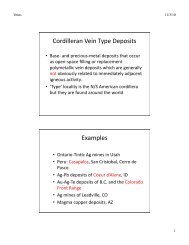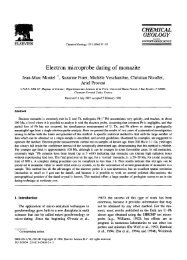Fe-Zn-S system and the sphalerite geobarometer
Fe-Zn-S system and the sphalerite geobarometer
Fe-Zn-S system and the sphalerite geobarometer
Create successful ePaper yourself
Turn your PDF publications into a flip-book with our unique Google optimized e-Paper software.
Geo<strong>the</strong>rmometry/Barometry<br />
Exsolution, Equilibration <strong>and</strong><br />
Stable Isotopes<br />
Stable Isotopes<br />
� Same # protons, different # neutrons<br />
� Different isotopes of <strong>the</strong> same element will<br />
behave differently due to this mass<br />
difference<br />
� In Economic Geology we use <strong>the</strong>se<br />
differences for <strong>the</strong>rmometry, tracking<br />
extent of equilibrium, water/rock<br />
interactions, sources of fluids <strong>and</strong> ore<br />
components<br />
Temperatures/Pressures<br />
� Fluid Inclusions<br />
� Stable isotopes<br />
� Sulfide <strong>the</strong>rmometry/barometry<br />
� Inversions - Polymorphs<br />
� Exsolution relationships<br />
Important Systems<br />
O 16 99.756 O 17 0.039 O 18 0.205<br />
H 1 99.985 H 2 =D 0.015 H 3<br />
12.26 yr<br />
half life<br />
C12 98.89 C13 1.11 C14 5700 yr<br />
half life<br />
S 32 95.02 S 33 0.75 S 34 4.21 S 36 0.02<br />
1
How do we get <strong>the</strong>m out?<br />
� Carbonates: phosphoric acid -> CO 2<br />
� Silicates: reaction w/ BrF 5, F 2, ClF 3 -> O<br />
� O + hot graphite -> CO 2<br />
� Sulfides: heat w/ oxidant e.g. CuO<br />
� S + O -> SO 2<br />
� Or S + F source -> SF 6<br />
� OH or H 2O: reaction w/ hot U or <strong>Zn</strong> -> H 2<br />
� Now: Direct laser fluorination<br />
Ratios: Del/Delta Terminology<br />
� δO 18 , δD, δC 13 , δS 34<br />
� δ = (R sample/R std -1) * 1000<br />
� where<br />
� R sample = (O 18 sample /O16 sample )<br />
� Ex: a δ of +10 => sample 1% heavier than<br />
<strong>the</strong> st<strong>and</strong>ard<br />
St<strong>and</strong>ards<br />
� Very difficult to measure absolute<br />
amounts so always use st<strong>and</strong>ards<br />
allowing ratio measurements<br />
� O & H: referred to SMOW<br />
� Soft rockers may refer O to PDB<br />
� C: belemnite from <strong>the</strong> Pee Dee Fm: PDB<br />
� S: Canyon Diablo meteorite troilite: CDT<br />
Fractionation Factors<br />
� See reading for relationship of <strong>the</strong> delta<br />
notation to more rigorous derivation of <strong>the</strong><br />
fractionation factor between 2 minerals or<br />
phases yielding diagrams with axis of:<br />
� 10 3 lnα A-B<br />
� 10 3 lnα A-B ~ δ A - δ B = Δ AB<br />
2
See Figures for:<br />
� Equipment schematic<br />
� Natural Ranges<br />
� Causes?<br />
� Gas/Liquid, Liquid/Solid, Solid/Solid<br />
� Problems:<br />
� Calibrations, Analytical uncertainty,<br />
Retrogression, Non-contemporaneous phases,<br />
Scale of equilibrium, possible effects of salinity,<br />
pH, ƒ(CO 2 ), …<br />
Traditional Extraction Line<br />
Schematic Mass Spec. Natural Ranges on Earth<br />
3
Fractionations Among Sulfides Sulfide Thermometry<br />
Sulfide/Fluid Speciation<br />
Fractionations<br />
Seawater<br />
Sulfate vs<br />
Time<br />
4
Sediment Hosted Orogenic Au<br />
Progressive Oxygen Isotope<br />
Fractionation<br />
Progressive Oxygen & Hydrogen<br />
Isotope Fractionation D/O 18 - Water Reservoirs<br />
5
D/O 18 - Geo<strong>the</strong>rmal Fluids Oxygen Isotope Thermometry<br />
<strong>Fe</strong>-<strong>Zn</strong>-S <strong>system</strong> <strong>and</strong> <strong>the</strong><br />
<strong>sphalerite</strong> <strong>geobarometer</strong>!<br />
� Iron content of <strong>sphalerite</strong> depends on aS 2 <strong>and</strong><br />
pressure!<br />
� Phase equilibria studies have revealed that <strong>the</strong> iron content of<br />
<strong>sphalerite</strong> equilibrated with pyrite <strong>and</strong> pyrrhotite, although<br />
temperature independent between about 300° <strong>and</strong> 550°C, is<br />
pressure dependent. !<br />
� This relationship has been defined (Scott <strong>and</strong> Barnes, 1971;<br />
Scott 1973) <strong>and</strong> thus allows <strong>the</strong> <strong>sphalerite</strong> composition in this<br />
assemblage to serve as a <strong>geobarometer</strong>. The equation below<br />
relates iron content (as <strong>Fe</strong>S) to <strong>the</strong> pressure of equilibration<br />
(Hutchison <strong>and</strong> Scott 1980): !<br />
� P bar =42.30-32.10 log mole% <strong>Fe</strong>S. !<br />
6
Sphalerite<br />
<strong>geobarometer</strong><br />
Plot of <strong>the</strong> <strong>Fe</strong>S content<br />
of <strong>sphalerite</strong> coexisting<br />
with pyrite <strong>and</strong><br />
hexagonal pyrrhotite at<br />
0, 2.5, 5, 7.5, <strong>and</strong> 10<br />
kbars at temperatures<br />
from 300° to 700°C.<br />
Sphalerite with “chalcopyrite disease”:<br />
Exsolution? Diffusion? Replacement?!<br />
<strong>Fe</strong>S content of <strong>sphalerite</strong> in equilibrium with<br />
pyrite <strong>and</strong> pyrrhotite as a function of P at 300°C!<br />
Geo<strong>the</strong>rmometers<br />
� Geo<strong>the</strong>rmometers are of two types<br />
� 1. Sliding scale<br />
� 2. Fixed point<br />
� Sliding scale geo<strong>the</strong>rmometers are based on <strong>the</strong> temperature<br />
dependence of <strong>the</strong> composition of a mineral or pair of minerals<br />
when <strong>the</strong>y are part of a specified assemblage.<br />
� Arsenopyrite geo<strong>the</strong>rmometer:<br />
� when equilibrated with pyrite, pyrrhotite, loellingite as shown in<br />
next figure<br />
7
<strong>Fe</strong>-As-S <strong>system</strong> <strong>and</strong> <strong>the</strong> arsenopyrite<br />
geo<strong>the</strong>rmometer!<br />
� Barton <strong>and</strong> Skinner (1979) <strong>and</strong> Vaughan<br />
<strong>and</strong> Craig (1978) have prepared extensive<br />
lists of reaction points that serve as<br />
potentially useful fixed point<br />
geo<strong>the</strong>rmometers. Fig. 4 shows <strong>the</strong><br />
invariant points of S-Sb, S-Se, <strong>and</strong> S-Sn<br />
<strong>system</strong>s that are of possible interest to <strong>the</strong><br />
geo<strong>the</strong>rmometry of an ore deposit.<br />
� Fixed point geo<strong>the</strong>rmometers are minerals or<br />
mineral assemblages that undergo a reaction<br />
(e.g. melting, inversion, reaction to form a<br />
different assemblage) at a defined temperature.<br />
For example, crystals of stibnite must have<br />
formed below its melting point (556°C) <strong>and</strong> <strong>the</strong><br />
mineral pair pyrite+arsenopyrite must have<br />
formed below 491°C. The fixed points thus do not<br />
sharply define <strong>the</strong> temperature of equilibrium but<br />
ra<strong>the</strong>r set upper <strong>and</strong> lower limits.<br />
8





